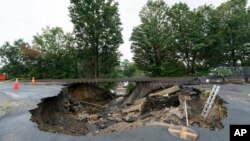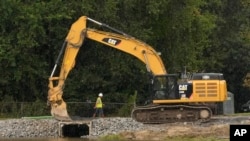The floods this week in Massachusetts that put a few dams at risk have raised concern the structures may increasingly be at risk as the region is hit by stronger and wetter storms.
There are thousands of dams across New England and many were built decades if not centuries ago, often to help power textile mills, store water or supply irrigation to farms. The concern is they have outlived their usefulness and climate change could bring storms they were never built to withstand.
"When they were built, the climate was different. The design storms were different," said Robert Kearns, a climate resilience specialist with the Charles River Watershed Association.
Leominster, Massachusetts, Kearns noted, got almost 27.9 centimeters of rain over several hours Monday night. At least two of the city's 24 dams nearly failed this week, prompting the city to recommend residents evacuate before the threat subsided.
"This infrastructure, the culverts, the dams, they were not built for the volume of water that we're seeing and we're going to continue to see in the future," he added.
A federal database lists nearly 4,000 dams in New England, with 176 categorized as high-hazard structures that are in either poor or unsatisfactory condition. If these dams fail, they would pose a risk to people living downstream as well as roads, neighborhoods and key infrastructure such as water treatment plants.
An investigation by The Associated Press in 2022 found the number of high-hazard dams was on the rise: More than 2,200 nationwide, up substantially from a similar AP review conducted three years earlier. The number is likely even higher, although it's unclear because some states don't track the data and many federal agencies refuse to release details about dam conditions.
In the 2019 AP investigation, a review of inspection reports found a host of problems with the dams, including leaks indicating internal failure, unrepaired erosion, holes from burrowing animals and extensive tree growth, which can destabilize earthen dams. In some cases, inspectors flagged spillways too small to handle the amount of water that could result from increasingly intense rainstorms.
Part of the challenge is dam safety has long been ignored by policymakers, requiring many states to run their dam safety programs on shoestring budgets and repairs can take years. Advocates also say many programs lack transparency so communities may not even know a dangerous dam upstream poses a risk, while others complain dam safety officials have been slow to recognize the threat of climate change.
"We are not seeing a shift in mindset related to dams that we should be seeing in light of the massive changes we're seeing from climate change in terms of particularly more extreme storms," said Emily Norton, executive director of the Charles River Watershed Association. "We think there should be much more sense of urgency about dam assessment and dam removal."
Christine Hatch, a University of Massachusetts Amherst hydrogeologist, said Massachusetts needs to do a statewide dam assessment to determine how best to spend its limited resources.
"The reality of climate change is that whatever we thought was safe enough when we built it isn't safe enough anymore," Hatch said. "There isn't enough money to upsize all those or retrofit them."
An assessment is needed to decide which dams are essential and which are dangerous, Hatch said.
New England has seen numerous dam failures over the years.
More than 50 have failed in New Hampshire over the past century, including the Meadow Pond Dam, which ruptured in 1996, killing a woman and flooding a neighborhood. There have been about 70 in Vermont, including the 1947 failure of East Pittsford Dam that devastated Rutland.
Five failed in Rhode Island during a 2010 storm, prompting the state to examine all dam spillways. A 2019 study found a quarter of the state's high-hazard dams could not hold up to a 100-year storm — an event with a 1% chance of happening in a given year — and 17% couldn't survive a 500-year storm, which has a 0.2% chance of occurring in a year.
Several dams nearly failed in Vermont this summer during heavy flooding, including one that would have inundated parts of Montpelier, the capital.
Massachusetts Gov. Maura Healey said Wednesday that the administration is keeping an eye on dams across the state.
"We have already monitored the conditions of dams in many communities. Our Office of Dam Safety was on the ground, particularly in Leominster, the other day to take quick action working with others to make sure those dams were shored up. But it's something we're going to continue to watch," Healey said.
Healey has warned about the increasing toll of climate change. A series of recent storms, including torrential rains in July that flooded farms in western Massachusetts, have highlighted the importance or bolstering the state's defenses, she said.
"Obviously, this speaks to the need for federal funding which I'm pursuing and also the need for continued investments in resilience and in infrastructure because we've seen the devastating results of these storms," she said. "What we've seen with these storms, and it is different, is it can turn on a dime. The playbook can't be the same."
The Barrett Park Pond Dam, located on a 3.6-hectare pond in Leominster, suffered significant damage during this week's floods. Failure of the dam, which dates to the 1800s, could have sent water into a residential neighborhood downhill, state officials said.
Last inspected in 2021, the dam was found to be in poor condition. The city received a $163,500 grant for repairs but was still in the design phase when the flooding hit.
"The good news was that the 24 dams held," said Leominster's director of emergency management, Arthur Elbthal, adding that proposed repairs must go through the timely budget process.
"I do know what we have here is what we can build on," he said. "Certainly, we need to pay attention to them. ... Every piece of infrastructure, whether it's a road, a sewer line, a dam, we are always looking to keep them repaired and functioning as they should. I don't see any change in that now."










